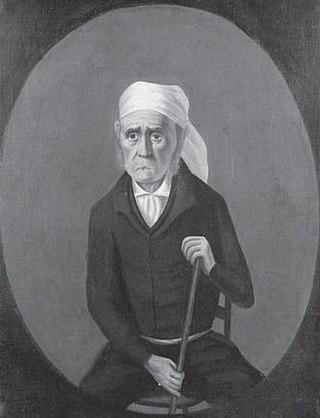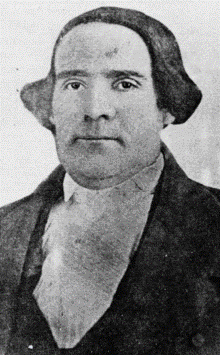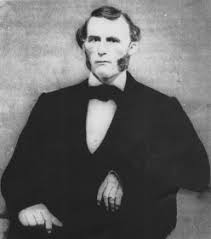Maria Josefa Jaramillo Carson | |
|---|---|
 | |
| Born | March 19, 1828 |
| Died | April 27, 1868 (aged 40) |
| Spouse | Christopher "Kit" Carson |
Maria Josefa Jaramillo Carson (March 19, 1828 - April 27, 1868) was the third wife of frontiersman Kit Carson. [1]
Maria Josefa Jaramillo Carson | |
|---|---|
 | |
| Born | March 19, 1828 |
| Died | April 27, 1868 (aged 40) |
| Spouse | Christopher "Kit" Carson |
Maria Josefa Jaramillo Carson (March 19, 1828 - April 27, 1868) was the third wife of frontiersman Kit Carson. [1]
Maria Josefa Jaramillo was born on March 19, 1828, at Santa Cruz de la Cañada, in the Rio Grande Valley near Taos. [2] Her father was Francisco Jaramillo, a respected merchant, and her mother was Maria Apolonia Vigil. Both the Jaramillo and Vigil families were prominent in the Taos area. They owned land in the Rio Grande Valley, [1] and moved to Taos when she was an infant. Her ancestors had migrated from Mexico City and Zacatecas to New Mexico during the Spanish reconquest in the 1690s. [2]
Jaramillo met Carson in 1842 when she was 14 years old. They were introduced by Governor Charles Bent, who married Jaramillo's sister, Maria Ignacia. [1] Jaramillo's father had reservations about Carson, who was illiterate and not a Catholic. Carson converted to Catholicism and was baptized on January 28, 1843. [3]
Jaramillo married Kit Carson on February 6, 1843, in Our Lady of Guadalupe Church. Governor Bent and Maria Ignacia hosted their wedding celebrations. [1] Jaramillo was known for her hospitality and care of neighbors. [4]
Carson called Jaramillo "Chipeta/Little Singing Bird" as a nickname. Carson left shortly after their wedding to continue US territorial expansion. Jaramillo spent 13 months alone without her husband. [1] She maintained their cabin on the Little Cimmaron River alone. [3] They only spent a brief period together, from 1854 to 1861, when Carson worked as an Indian agent in Taos. [4]
In 1847, while Carson was away, the Taos people revolted against the military and civil government. Rebels broke into the home where the family was staying and assassinated Bent and Jaramillo's brother. [5] Ignacia, Jaramillo, and the family escaped and stayed hidden until the rebellion was quelled. The adults were later eyewitnesses in the trials that followed. Carson and Jaramillo became the guardians of her brother's children. [4] The family left Taos and moved to Rayado. [5]
The couple had six biological children together: [1] Charles Bent Carson (1849-1851), William Carson (b.1852), Teresina (b. 1854) Cristoval Charles (b. 1858), Rebecca (b. 1864), and Estefana Stella (b. 1868). Additionally, they "adopted" three Native American orphans. [3]
When the Civil War broke out, Carson joined the Union army. When he learned that Confederate soldiers were advancing on Taos, he notified Jaramillo, who fled with the family. She hid any money and valuables they had on one of the adopted Native American children. They met a group of Ute peoples who had a Diné boy in tow. The travelers said the boy was troublesome and they would kill him. Jaramillo traded one of their horses for the child, and they adopted him. [3] According to scholar Johnson, "Tales like these were consistent with the apologetics of captivity in New Mexico, where claims of rescue and kinship obscured the coercion of slavery". [2]
In 1865, Carson became Superintendent of Indian Affairs for Colorado Territory, and the family moved to Boggsville, Colorado. [1]
Maria Josefa Jaramillo Carson died on April 27, 1868, at age 40, [4] due to complications from childbirth. Carson died shortly after, and the couple were buried together. They now rest in the Kit Carson Park cemetery in Taos. [1]
Her descendants still speak of her with reverence for her perseverance despite her husband's absences and her strong familial connections and support. [2]
One of her descendants is historian librarian Charlene Garcia Simms.

Christopher Houston Carson was an American frontiersman. He was a fur trapper, wilderness guide, Indian agent and U.S. Army officer. He became a frontier legend in his own lifetime by biographies and news articles; exaggerated versions of his exploits were the subject of dime novels. His understated nature belied confirmed reports of his fearlessness, combat skills, tenacity, as well as profound effect on the westward expansion of the United States. Although he was famous for much of his life, historians in later years have written that Kit Carson did not like, want, or even fully understand the fame that he experienced during his life.

Taos is a town in Taos County in the north-central region of New Mexico in the Sangre de Cristo Mountains. Initially founded in 1615, it was intermittently occupied until its formal establishment in 1795 by Nuevo México Governor Fernando Chacón to act as fortified plaza and trading outpost for the neighboring Native American Taos Pueblo and Hispano communities, including Ranchos de Taos, Cañon, Taos Canyon, Ranchitos, El Prado, and Arroyo Seco. The town was incorporated in 1934. As of the 2010 census, its population was 5,716.

Charles Bent was an American businessman and politician who served as the first civilian United States governor of the New Mexico Territory, newly invaded and occupied by the United States during the Mexican-American War by the Military Governor, Stephen Watts Kearny, in September 1846.

Ceran St. Vrain, born Ceran de Hault de Lassus de Saint-Vrain, was the son of a French aristocrat who emigrated to the Spanish Louisiana in the late 18th century; his mother was from St. Louis, where he was born. To gain the ability to trade, in 1831 he became a naturalized Mexican citizen in what is now the state of New Mexico. He formed a partnership with American traders William, George and Charles Bent; together they established the trading post of Bent's Fort. It was the only privately held fort in the West.

The Taos Revolt was a popular insurrection in January 1847 by Hispano and Pueblo allies against the United States' occupation of present-day northern New Mexico during the Mexican–American War. Provisional governor Charles Bent and several other Americans were killed by the rebels. In two short campaigns, United States troops and militia crushed the rebellion of the Hispano and Pueblo people. The New Mexicans, seeking better representation, regrouped and fought three more engagements, but after being defeated, they abandoned open warfare. Hatred of New Mexicans for the occupying American army combined with the oft-exercised rebelliousness of Taos residents against authority imposed on them from elsewhere were causes of the revolt. In the aftermath of the revolt the Americans executed at least 28 rebels. The Treaty of Guadalupe Hidalgo in 1848 guaranteed the property rights of New Mexico's Hispanic and American Indian residents.

Antonio José Martínez was a New Mexican priest, educator, publisher, rancher, farmer, community leader, and politician. He lived through and influenced three distinct periods of New Mexico's history: the Spanish period, the Mexican period, and the American occupation and subsequent territorial period. Martínez appears as a character in Willa Cather's novel, Death Comes for the Archbishop.

María Ignacia Rodríguez de Velasco y Osorio Barba, known as la Güera Rodríguez was a wealthy American-born Spanish woman and a proponent of Mexican independence, today considered a heroine of independence. She was a longtime friend of Agustín de Iturbide, a royal army officer who later led the movement in New Spain for independence. In the 1840s she became friends with Fanny Calderón de la Barca, whose published observations of Mexico helped fuel interest in Rodríguez's story.
Tom Tobin (1823–1904) was an American adventurer, tracker, trapper, mountain man, guide, US Army scout, and occasional bounty hunter. Tobin explored much of southern Colorado, including the Pueblo area. He associated with men such as Kit Carson, "Uncle Dick" Wootton, Ceran St. Vrain, Charley Bent, John C. Fremont, "Wild Bill" Hickok, William F. Cody, and the Shoup brothers. Tobin was one of only two men to escape alive from the siege of Turley's Mill and Distillery during the Taos Revolt. In later years he was sent by the Army to track down and kill the notorious Felipe Espinosa and his nephew; Tobin returned to Ft. Garland with their heads in a sack.

Lucien Bonaparte Maxwell was a mountain man, rancher, scout, and farmer who at one point owned more than 1,700,000 acres (6,900 km2). Along with Thomas Catron and Ted Turner, Maxwell was one of the largest private landowners in United States history. In 1959, he was inducted into the Hall of Great Westerners of the National Cowboy & Western Heritage Museum.
Guadalupe Miranda was a Mexican public official who was mayor of Ciudad Juárez and recipient of the 1,700,000-acre (6,900 km2) Beaubien-Miranda Land Grant.

The Kit Carson House is a historic house museum at 113 Kit Carson Road in central Taos, New Mexico. Built in 1825, it was from 1843 until his death the home of frontiersman Kit Carson (1809-1868). A good example of Spanish Colonial architecture, it is now owned by the local Masonic fraternity, and serves as a museum dedicated to Carson's life. It was designated a National Historic Landmark in 1963.

The Ávila family was a prominent Californio family of Spanish origins from Southern California, founded by Cornelio Ávila in the 1780s. Numerous members of the family held important rancho grants and political positions, including two Alcaldes of Los Angeles.
Rancho Los Coches was a 8,794-acre (35.59 km2) Mexican land grant in present-day Monterey County, California given in 1841 by Governor Juan Alvarado to María Josefa Soberanes. The name means "the pigs". The grant was south of Soledad and extended along the Arroyo Seco.
Rancho San Bernardo was a 4,379-acre (17.72 km2) Mexican land grant, in present-day San Luis Obispo County, California, given in 1840 by Governor Juan B. Alvarado to Vicente Canet.

Donaciano Vigil (1802-1877) was an American politician who served as the second governor of the New Mexico Territory. Born a subject of the Spanish Crown in Santa Fe to Nuevomexicanos parents, he served in the militias during Mexican rule in New Mexico. After the United States annexed New Mexico following the Mexican–American War, Vigil helped smooth the transition to American governance.
Auguste Sylvestre LaCome was a French settler and trader in the New Mexico Territory and brother of Jean Baptiste LaCome. He was an investigator to the White massacre.

Taos Downtown Historic District is a historic district in Taos, New Mexico. Taos "played a major role in the development of New Mexico, under Spanish, Mexican, and American governments." It is a key historical feature of the Enchanted Circle Scenic Byway of northern New Mexico.
The Turley Mill and Distillery Site is a historic site on the Rio Hondo about 11 miles (18 km) north of Taos, New Mexico. It was a mill and distillery which served as the headquarters of Simeon Turley's commercial and manufacturing empire. Simeon Turley (1809–1847) and his brothers Stephen Turley (1786–1851) and Jesse B. Turley (1801–1861) transported goods from Franklin, Missouri to Taos via wagon train on the Santa Fe Trail. About 1827–1829 Simeon settled in Arroyo Hondo and established the mill and distillery as a popular trading post and "watering hole." Simeon was murdered in the Taos Revolt of January 1847 and the mill and distillery site was all but destroyed. Simeon Turley is buried in the Kit Carson Memorial Cemetery in Taos. The mill and distillery site was listed on the State of New Mexico Register of Cultural Properties in 1969 and on the National Register of Historic Places in 1978.

Alexis Godey also called Alec Godey and Alejandro Godey, born Alexander Godey, was a trapper, scout, and mountain man. He was an associate of Jim Bridger and was lead scout for John C. Frémont.
Juanita Jaramillo Lavadie is a contemporary weaver, textile scholar and muralist based in New Mexico. Her art is centered on the acequia system in Taos County, Northern, New Mexico and is influenced by traditional Hispano and Indigenous cultures. Her work primarily focuses on water rights in Taos County.